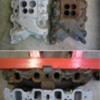Below is a picture of two different 4 barrel carburetor Cleveland intake manifolds.
One is cast in aluminum, and is designed for the spread bore Autolite 4300D carburetor.
The other is cast in iron, and is designed for the "square bore" Autolite 4300A or Holley carburetors.
The second picture reveals the size of the runners of each manifold. The aluminum manifold has the expected large, 4V size runners. But, the iron manifold has the smaller 2V size runners.
Here's the two part trivia question:
1. Which specific motor or Ford automobile was the aluminum manifold installed in.
2. Where was the iron manifold cast?
Attachments
Original Post



